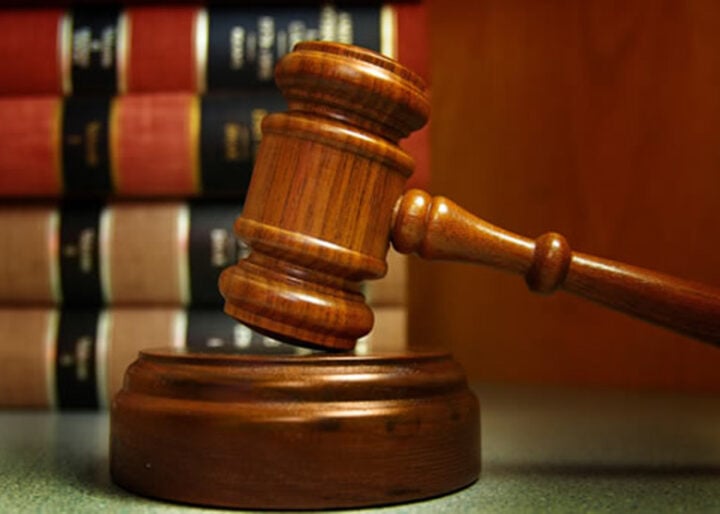Pic.2. A petrol hawker approaches a crowded fuel station with his empty jerry cans at Dutse Junction in Abuja on Monday (1/3/21).
00854/1/3/2021/Jones Bamidele/NAN
In July this year, the Minister of Finance, Budget and National Planning, Hajiya Zainab Ahmed, affirmed that government subsidy on petrol had risen to some ₦150 billion monthly and made a strident case for its removal altogether.
The issue of subsidy has been a thorny one in recent years and its burden on the nation’s economy has always been trumpeted by the nation’s economic managers and various other stakeholders.
Hajiya Ahmed raised cogent points to support her assertion:
“We have a situation wherein, in a month, the subsidy costs as much as 150 billion Naira….that is money that the federation account, federal and state governments forgo. If this revenue is available to fund education, infrastructure, health, it will reduce our borrowing. It will reduce the crises that states are having of not being able to pay salaries….”
Advertisement
A few days before the Minister made that call, the Managing Director of Nigerian National Petroleum Corporation(NNPC), Mele Kyari had said the pump head price of fuel should, at least, read ₦256 per litre, given the market dictates of that time.
Few will argue with the fact that the subsidy overhang has become an albatross on the weary neck of the nation’s straining economy, especially if viewed from the Petroleum Products Pricing and Regulatory Authority’s (PPPRA) claim a year ago, that some ₦8.94 trillion was utilised on subsiding petrol between 2006 and 2015.
For many though, the colossal subsidy amount(s) could only be attributable to bridging and other ancillary costs such as marine transport and transporters allowance (reimbursable made to marketers for moving petrol in trucks/barges to filling stations and floating mega stations in riverine areas), to maintain price parity all over the country. That is not the case.
Advertisement
For emphasis, whilst bridging and its ancillaries are components of the PPPRA’s pricing template, they do not, in any shape or form, represent the entire gamut of the subsidy regime.
In March this year, there was a general uproar when the PPPRA hoisted the Guiding Prices of its template for the month, on its website. The Agency had indicated that owing to market trends, petrol price should attract a figure of ₦212.61 (upper band) per litre, at filling stations. The din that followed the information release was so jarring, it reverberated ceaselessly all over Aso Rock corridors and beyond.
Needless to say, the Federal Government, through the NNPC, quickly responded and doused the combustible atmosphere, explaining that there was no plan to effect any price increase.
The PPPRA also towed the government line and claimed its position was merely advisory and that it was in no way, advocating for a hike in price. The Agency, perhaps in hearkening to advice emanating from the corridors of power, quickly yanked off the ‘offending’ Guiding Prices from its website.
Advertisement
Such is how volatile and inflammable the issue of petrol price could be for the Nigerian people, most of whom are reeling under some heavy and punishing economic burden at the moment.
However, for this piece, the PPPRA March 2021 template would be borrowed to differentiate the real subsidy from bridging and ancillaries.
According to the Agency, the Average Petrol Price (Free on Board Rotterdam Barge) amounted to ₦169.22 per litre. Average Freight came to ₦6.51 a litre, bringing Ex-Coastal Price to ₦175.73 per litre. Adding Average Lightering Expenses, Nigeria Port Authority(NPA), Nigeria Maritime Administration and Safety Agency(NIMASA), Jetty Thru’Put, Average Financing Cost and Storage Charges pushed the Expected Landing Cost to some ₦189.61 a litre.
The Expected Ex-Depot price which summed up at ₦206.42/litre, had the following as ₦ components per litre:
Advertisement
Wholesalers Margin – 4.03
Transporters Allowance – 3.89
Advertisement
Marine Transport Average – 0.15
Bridging Fund – 7.51
Advertisement
Admin Charge – 1.23
Retailers Margin was put at ₦6.19 per litre with Expected Retail Price, Lower and Upper Band suggested at ₦209.61 and ₦212.61 per litre, respectively. An exchange rate of ₦403.80 against the dollar, was employed for calculating the import segment of the costs applied.
Advertisement
From all enunciated above, it clearly showed that Bridging cost and its ancillaries – Marine Transport Average and Transporters Allowance – amounted to ₦11.55 a litre for March out of the Upper Band suggestion of ₦212.61 per litre as indicated by the Regulatory Agency. What amounted to a large chunk of the template’s components was fuel importation and import-related charges.
Currently, petrol is being sold by most filling stations at ₦162 per litre. That leaves a gap of ₦50.61 when that amount is deducted from the ₦212.61 a litre (PPPRA March suggestion). For many, that ₦50.61 is what constitutes subsidy whereas bridging and ancillaries accounted for only ₦11.55 of that sum. The subsidy in real figures, and this particular scenario, is ₦39.06 and that’s almost 3.4 times more than the amount suggested for compensating marketers in making petrol prices uniform across Nigeria.
The case for maintaining the bridging fund and ancillary transport costs
In Nigeria, there are no social safety nets as such. Pensioners are even having a harried time collecting their dues at intervals, not to mention the burgeoning unemployment/underemployment plaguing the country.
Subsidies are generally popular with Governments in Europe and North America and are applied to a wide range of businesses such as agriculture, transport, oil and gas to mention a few. Welfare payments are also made to the indigent, by most.
It is on record that the United States, for example, subsidises farmers to be tune of 20 billion dollars a year. At the height of the covid pandemic last year, most farmers in America thrashed their produce because they couldn’t get the same to consumers as truckers stayed home. The government stood solidly behind the farmers, offered them succour, and ensured that they did not go out of business. Also, according to the US Environmental Study Institute, direct subsidies to fossil fuel industries average $20 billion a year, with 15 billion of that sum provided by the Federal Government.
A European Union report estimated that the UK subsidised fossil fuels to the tune of £10.5 billion in 2018, according to a piece published by The Guardian (London), in January 2019.
SWI swissinfo.ch, an information platform of the Swiss Broadcasting Corporation published a report in February last year, quoting the Swiss Conference for Social Assistance that “the welfare system makes an essential contribution to social harmony in Switzerland and guarantees that all people live in dignity”. (The bulk of Nigerians are not really living dignified lives at the moment). It was estimated that the sum of 2.8 billion dollars was spent on 270,000 indigent people in 2018. And only half of those were Swiss! Asylum seekers and refugees are also covered under the country’s welfare scheme. Even struggling pensioners can always apply for “supplementary benefits”.
Since Nigeria does not have mitigants against poverty as enunciated above (at least for now), it behoves the government to ensure there’s parity in petrol prices across the land even if the ‘main subsidy’ is to be dispensed with. This can only be achieved if the costs of transporting fuel still hold firmly in the template for Guiding Prices. Otherwise, the resultant increase in uneven or convoluted fuel prices would result in higher costs of conducting business, with transportation of goods and services heavily impacted. It could also trigger accelerated unemployment, ramp up rural-urban migration, exacerbate environmental pollution, give rise to increased banditry, elevate kidnapping and generally fuelling mammoth insecurity across the land.
More importantly, the ₦11.55 utilised in moving products all over Nigeria, (including the riverine areas and mountainous terrains), is not sourced from the federation account and therefore not subsidised as it is worked into the template for fuel consumers.
Getting Refineries and Pipelines working
From the analysis drawn afore, no soothsayer is required to point out that the nation needs to get its refineries and pipelines up and running as quickly as practicable if we are to stem the colossal sums expended on imported gasoline.
In April, the NNPC signed a $1.5 billion contract with an Italian company – Maire Tecnimont – for the repairs of the 210,000 barrels per day capacity, Port Harcourt refinery.
The other two refineries’ rehabilitation (Warri – 125,000 barrels per day and Kaduna -110,000 barrels/day) had also been approved by the Federal Executive Council (FEC) for $1.5 billion, and the contract awarded to Saipem SPA, (another notable Italian company), thereby potentially unlocking combined 445,000 barrels a day refined oil for motorists and small scale businesses. The three refineries are all expected to be running smoothly in 44 months.
The Executive Council also directed the NNPC to acquire a $2.76 billion (20 per cent stake), in the ongoing 650,000 barrels a day, Dangote refinery, located in Lekki Free Zone, Lagos. This refinery is expected to be operational next year.
Although some concerned citizens pooh-poohed the idea of rehabilitating the nation’s 3 refineries and made a plausible and spirited case for the outright sale of the facilities as a result of mismanagement, lack of maintenance and heavy operational losses suffered in the past, Petroleum Minister, Chief Timipriye Sylva has affirmed this time around, that operations and maintenance are integral parts of the contracts signed for reworking the refineries. He spoke after the FEC gave assent to the Port Harcourt rehabilitation in March:
“Talking about operations and maintenance, that has been a problem for our refineries and that was exhaustively discussed in council and the agreement is that we are going to appoint a professional operations and maintenance company to manage the refinery when it is finally rehabilitated”.
He went on, “it is actually one of the conditions presented by the lenders because the lenders said they can give us the money if we have a professional operations and maintenance company and that is already embedded in our discussions with the lenders. We are not going back on that”.
The gratifying point of note is that the Petroleum Industry Bill (PIA) would have taken root by the time the refineries are fully rehabilitated and the NNPC would also have morphed into a limited liability company, run along commercial lines, and in tandem with best global practices.
In effect, as the refineries are back on full steam and pipelines working perfectly, the sums incurred on fuel importation would have been nipped considerably and the polity can let out a huge sigh of relief from the burdensome subsidy.
Latest developments on PIA
A few days ago, President Muhammadu Buhari wrote to the Senate, seeking an amendment to the Petroleum Industry Bill which he signed into law, recently. In his letter to the Senate, the President among other solicitations sought an expansion of the Boards of Upstream Regulatory Commission (URC) and Nigerian Midstream and Downstream Regulatory Authority (NMDRA). He advanced his reasons for the move, stressing the need to maintaining a geopolitical balance in both Boards as a way of reflecting “national spread” and ensuring that all segments in the polity would be better served with the decisions reached by the directing bodies.
Also, the Commander in Chief in the letter included his nominees for key appointments into the URC and the NMDRA. All this came barely 48 hours after he gave directives that the NNPC Limited be immediately incorporated and approving the formation of a new Board.
The President’s latest action caught a good number of industry watchers by surprise, especially coming after only 37 days of signing the PIA into law. Whilst some see the development as a mark of his desire to see his dreams of driving a rejuvenated oil sector, taking immediate root and spunk, others see it in a different light. Those not enthused feel that the roles of the new Boards will clash with those of the steering committee, put in place and granted one year by the Federal Government, to kick-start the harmonisation processes of relevant departments and agencies in addition to providing a robust framework for PIA application.
What is not in doubt is that a new dawn is sweeping across the petroleum industry but some clarity is still required for a clear delineation of roles among bodies charged with effective and seamless PIA implementation to avoid rancour and overlapping of responsibilities. The nation can’t wait to start reaping the benefits of the PIA. It has been long in coming.
Eniola Olakunri, a Director of Oats Global Energy and public sector analyst, writes from Abuja







